Procurement and Contractual Law
VerifiedAdded on 2023/01/17
|15
|3835
|1
AI Summary
This document provides an overview of procurement and contractual law in the construction industry. It discusses the elements of the tort of negligence and the liability of parties involved. It also explores standard building contracts and the dispute resolution mechanisms available. Suitable for students studying law or construction management.
Contribute Materials
Your contribution can guide someone’s learning journey. Share your
documents today.
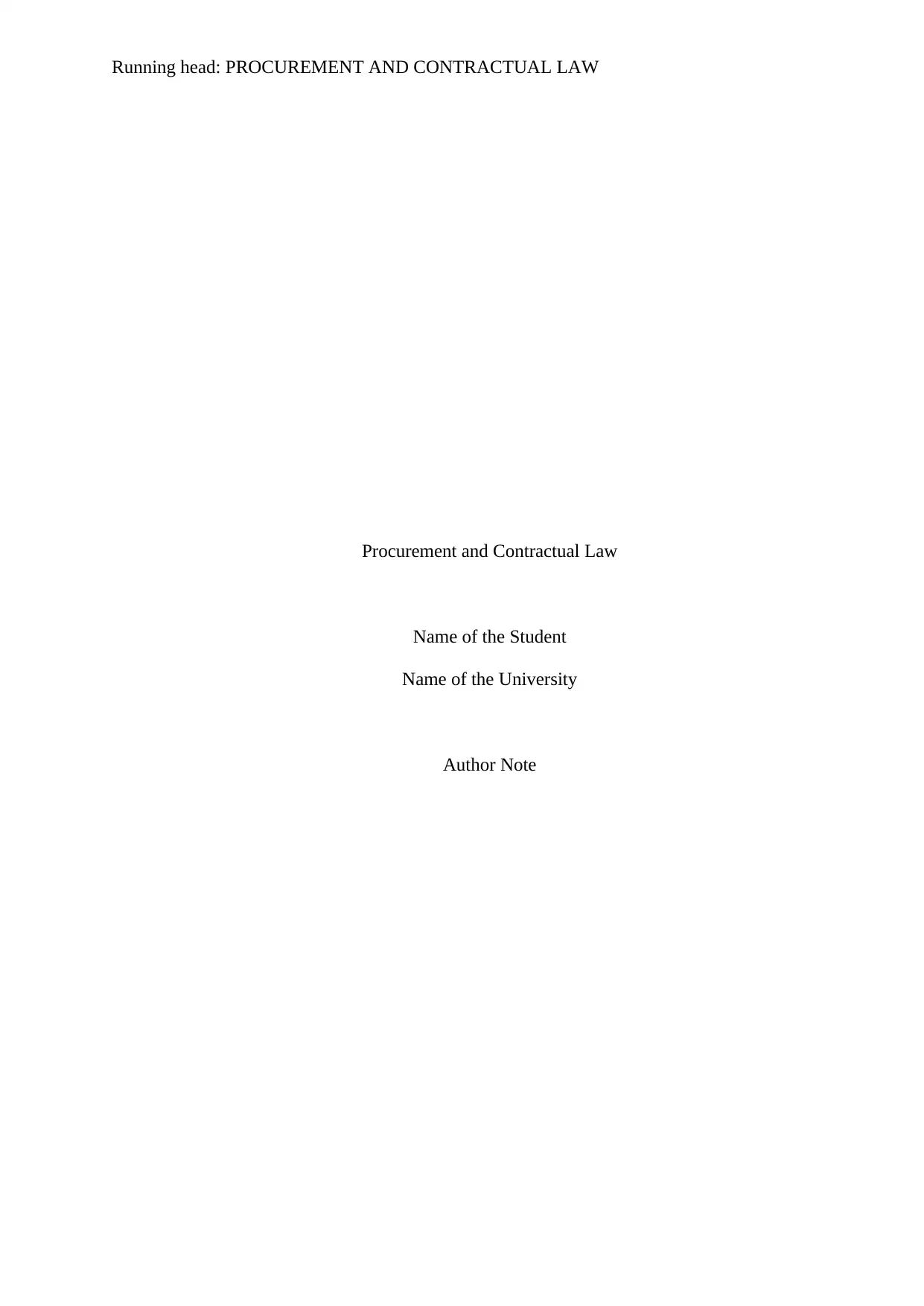
Running head: PROCUREMENT AND CONTRACTUAL LAW
Procurement and Contractual Law
Name of the Student
Name of the University
Author Note
Procurement and Contractual Law
Name of the Student
Name of the University
Author Note
Secure Best Marks with AI Grader
Need help grading? Try our AI Grader for instant feedback on your assignments.
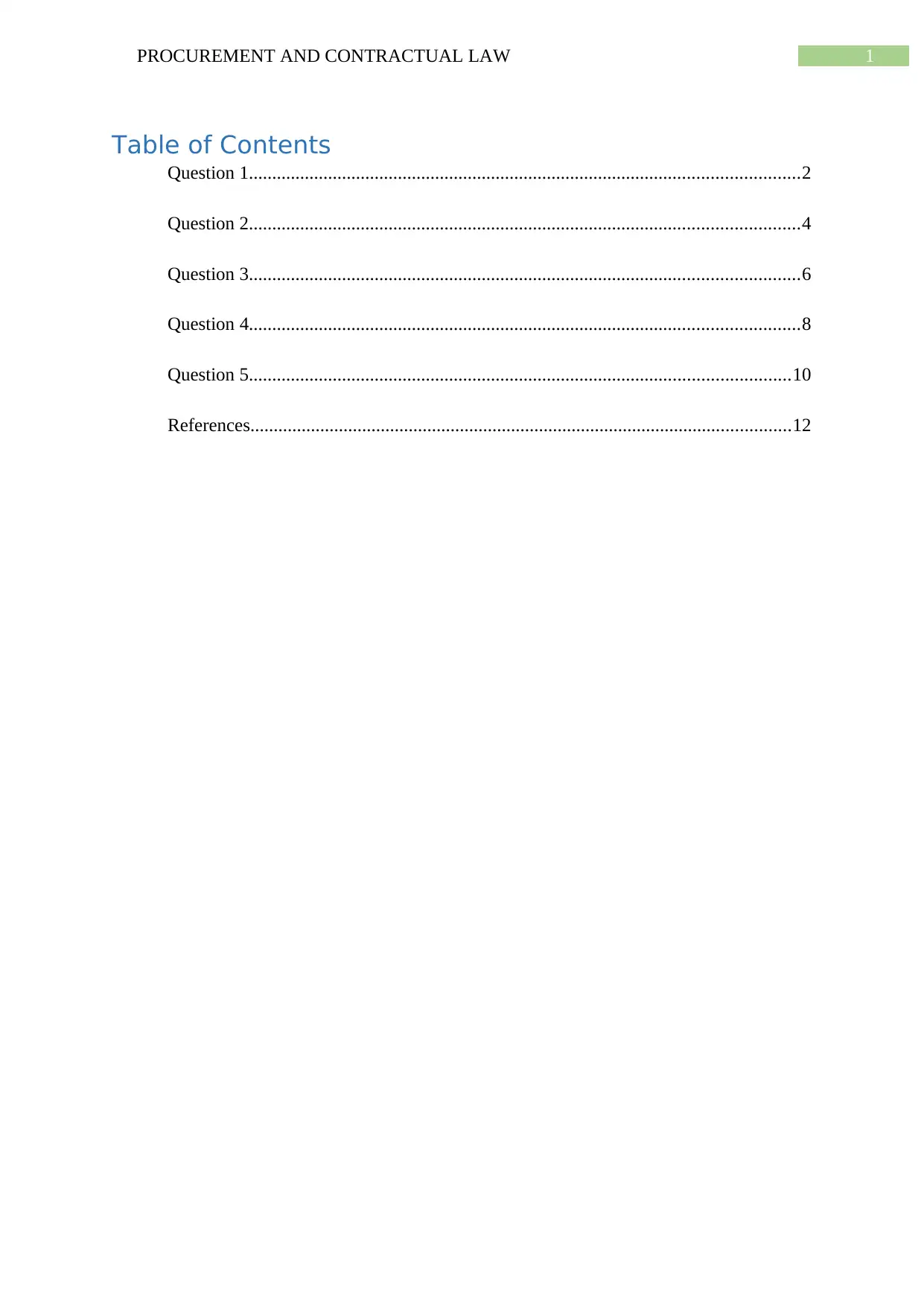
1PROCUREMENT AND CONTRACTUAL LAW
Table of Contents
Question 1......................................................................................................................2
Question 2......................................................................................................................4
Question 3......................................................................................................................6
Question 4......................................................................................................................8
Question 5....................................................................................................................10
References....................................................................................................................12
Table of Contents
Question 1......................................................................................................................2
Question 2......................................................................................................................4
Question 3......................................................................................................................6
Question 4......................................................................................................................8
Question 5....................................................................................................................10
References....................................................................................................................12
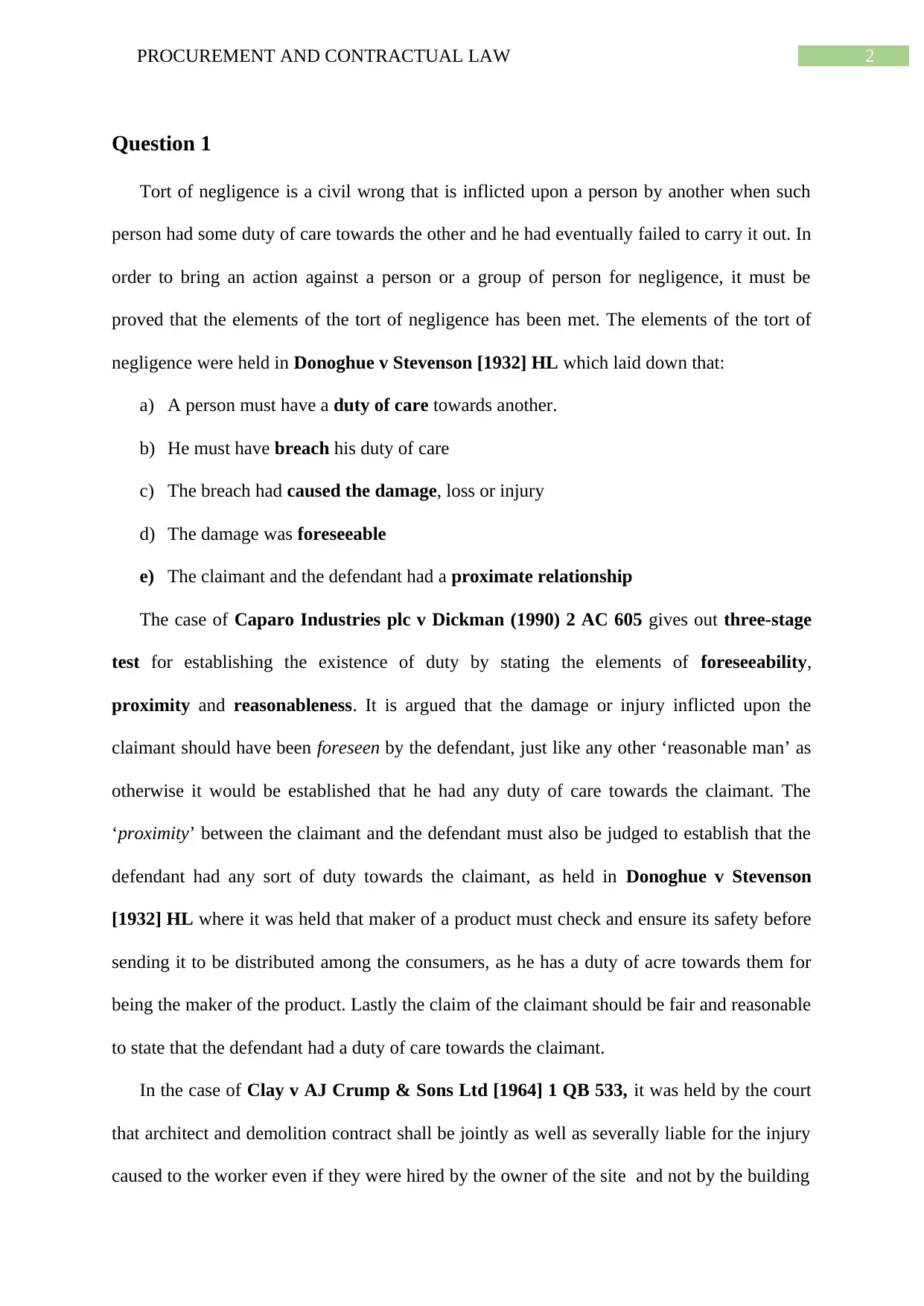
2PROCUREMENT AND CONTRACTUAL LAW
Question 1
Tort of negligence is a civil wrong that is inflicted upon a person by another when such
person had some duty of care towards the other and he had eventually failed to carry it out. In
order to bring an action against a person or a group of person for negligence, it must be
proved that the elements of the tort of negligence has been met. The elements of the tort of
negligence were held in Donoghue v Stevenson [1932] HL which laid down that:
a) A person must have a duty of care towards another.
b) He must have breach his duty of care
c) The breach had caused the damage, loss or injury
d) The damage was foreseeable
e) The claimant and the defendant had a proximate relationship
The case of Caparo Industries plc v Dickman (1990) 2 AC 605 gives out three-stage
test for establishing the existence of duty by stating the elements of foreseeability,
proximity and reasonableness. It is argued that the damage or injury inflicted upon the
claimant should have been foreseen by the defendant, just like any other ‘reasonable man’ as
otherwise it would be established that he had any duty of care towards the claimant. The
‘proximity’ between the claimant and the defendant must also be judged to establish that the
defendant had any sort of duty towards the claimant, as held in Donoghue v Stevenson
[1932] HL where it was held that maker of a product must check and ensure its safety before
sending it to be distributed among the consumers, as he has a duty of acre towards them for
being the maker of the product. Lastly the claim of the claimant should be fair and reasonable
to state that the defendant had a duty of care towards the claimant.
In the case of Clay v AJ Crump & Sons Ltd [1964] 1 QB 533, it was held by the court
that architect and demolition contract shall be jointly as well as severally liable for the injury
caused to the worker even if they were hired by the owner of the site and not by the building
Question 1
Tort of negligence is a civil wrong that is inflicted upon a person by another when such
person had some duty of care towards the other and he had eventually failed to carry it out. In
order to bring an action against a person or a group of person for negligence, it must be
proved that the elements of the tort of negligence has been met. The elements of the tort of
negligence were held in Donoghue v Stevenson [1932] HL which laid down that:
a) A person must have a duty of care towards another.
b) He must have breach his duty of care
c) The breach had caused the damage, loss or injury
d) The damage was foreseeable
e) The claimant and the defendant had a proximate relationship
The case of Caparo Industries plc v Dickman (1990) 2 AC 605 gives out three-stage
test for establishing the existence of duty by stating the elements of foreseeability,
proximity and reasonableness. It is argued that the damage or injury inflicted upon the
claimant should have been foreseen by the defendant, just like any other ‘reasonable man’ as
otherwise it would be established that he had any duty of care towards the claimant. The
‘proximity’ between the claimant and the defendant must also be judged to establish that the
defendant had any sort of duty towards the claimant, as held in Donoghue v Stevenson
[1932] HL where it was held that maker of a product must check and ensure its safety before
sending it to be distributed among the consumers, as he has a duty of acre towards them for
being the maker of the product. Lastly the claim of the claimant should be fair and reasonable
to state that the defendant had a duty of care towards the claimant.
In the case of Clay v AJ Crump & Sons Ltd [1964] 1 QB 533, it was held by the court
that architect and demolition contract shall be jointly as well as severally liable for the injury
caused to the worker even if they were hired by the owner of the site and not by the building
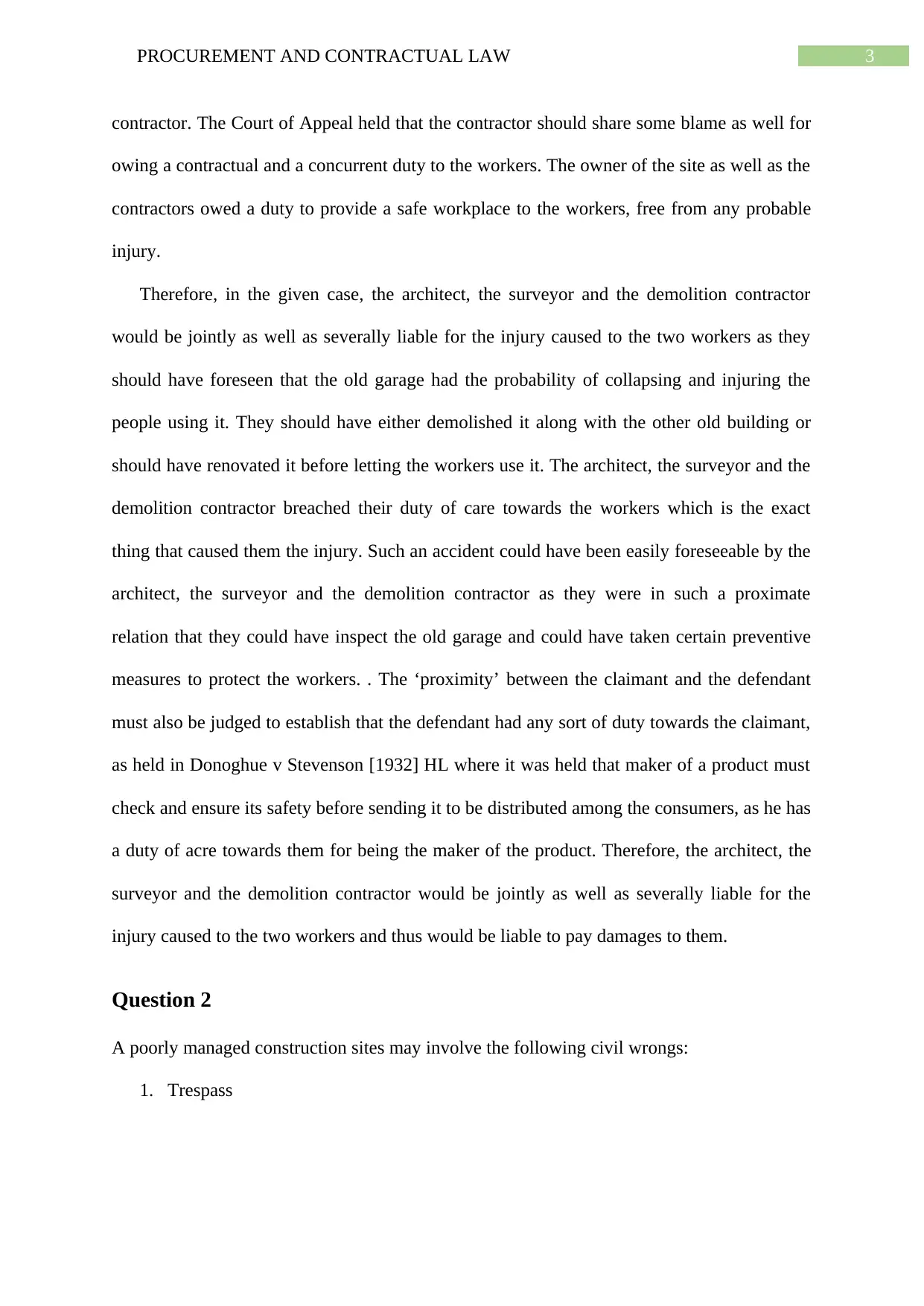
3PROCUREMENT AND CONTRACTUAL LAW
contractor. The Court of Appeal held that the contractor should share some blame as well for
owing a contractual and a concurrent duty to the workers. The owner of the site as well as the
contractors owed a duty to provide a safe workplace to the workers, free from any probable
injury.
Therefore, in the given case, the architect, the surveyor and the demolition contractor
would be jointly as well as severally liable for the injury caused to the two workers as they
should have foreseen that the old garage had the probability of collapsing and injuring the
people using it. They should have either demolished it along with the other old building or
should have renovated it before letting the workers use it. The architect, the surveyor and the
demolition contractor breached their duty of care towards the workers which is the exact
thing that caused them the injury. Such an accident could have been easily foreseeable by the
architect, the surveyor and the demolition contractor as they were in such a proximate
relation that they could have inspect the old garage and could have taken certain preventive
measures to protect the workers. . The ‘proximity’ between the claimant and the defendant
must also be judged to establish that the defendant had any sort of duty towards the claimant,
as held in Donoghue v Stevenson [1932] HL where it was held that maker of a product must
check and ensure its safety before sending it to be distributed among the consumers, as he has
a duty of acre towards them for being the maker of the product. Therefore, the architect, the
surveyor and the demolition contractor would be jointly as well as severally liable for the
injury caused to the two workers and thus would be liable to pay damages to them.
Question 2
A poorly managed construction sites may involve the following civil wrongs:
1. Trespass
contractor. The Court of Appeal held that the contractor should share some blame as well for
owing a contractual and a concurrent duty to the workers. The owner of the site as well as the
contractors owed a duty to provide a safe workplace to the workers, free from any probable
injury.
Therefore, in the given case, the architect, the surveyor and the demolition contractor
would be jointly as well as severally liable for the injury caused to the two workers as they
should have foreseen that the old garage had the probability of collapsing and injuring the
people using it. They should have either demolished it along with the other old building or
should have renovated it before letting the workers use it. The architect, the surveyor and the
demolition contractor breached their duty of care towards the workers which is the exact
thing that caused them the injury. Such an accident could have been easily foreseeable by the
architect, the surveyor and the demolition contractor as they were in such a proximate
relation that they could have inspect the old garage and could have taken certain preventive
measures to protect the workers. . The ‘proximity’ between the claimant and the defendant
must also be judged to establish that the defendant had any sort of duty towards the claimant,
as held in Donoghue v Stevenson [1932] HL where it was held that maker of a product must
check and ensure its safety before sending it to be distributed among the consumers, as he has
a duty of acre towards them for being the maker of the product. Therefore, the architect, the
surveyor and the demolition contractor would be jointly as well as severally liable for the
injury caused to the two workers and thus would be liable to pay damages to them.
Question 2
A poorly managed construction sites may involve the following civil wrongs:
1. Trespass
Secure Best Marks with AI Grader
Need help grading? Try our AI Grader for instant feedback on your assignments.
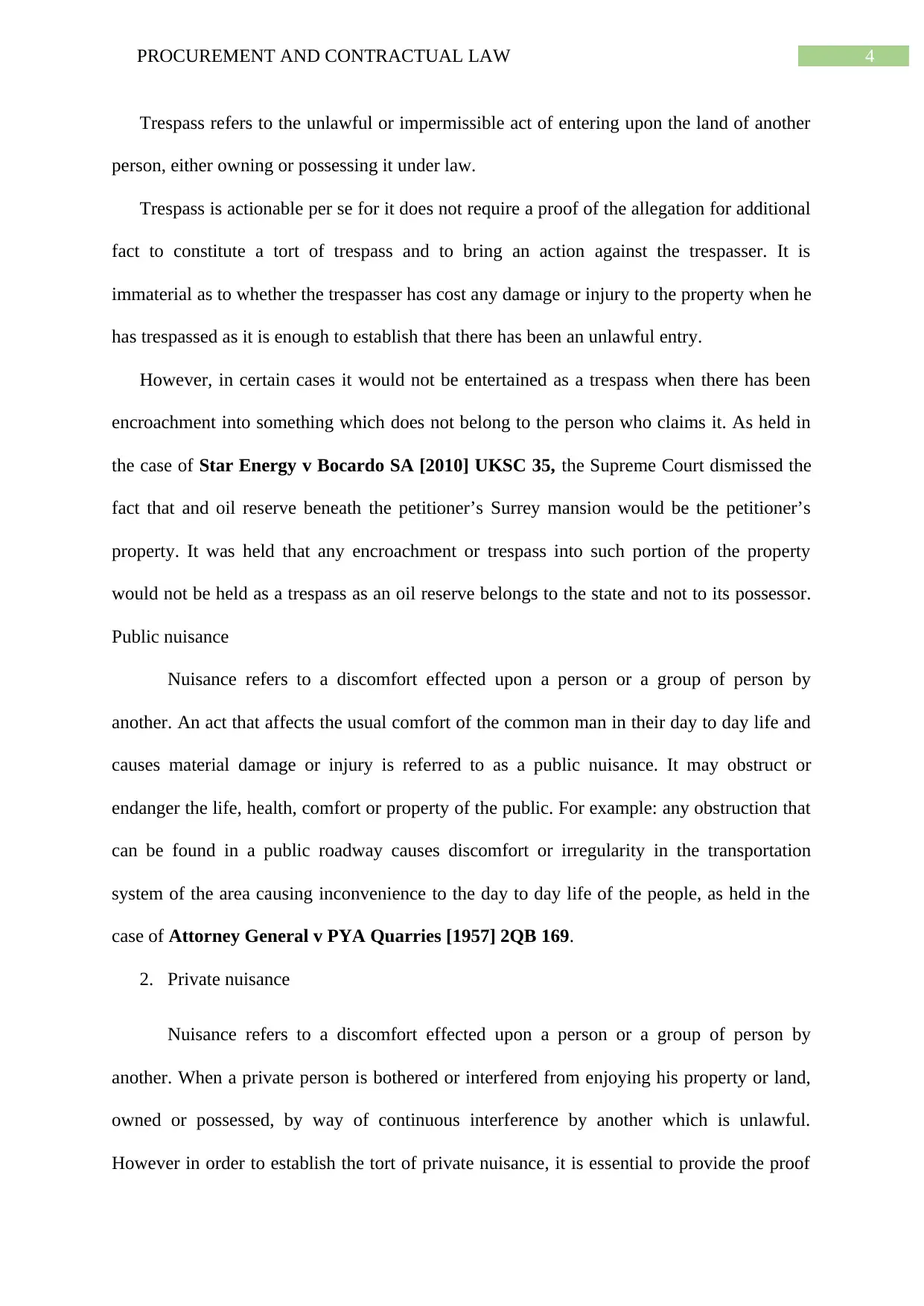
4PROCUREMENT AND CONTRACTUAL LAW
Trespass refers to the unlawful or impermissible act of entering upon the land of another
person, either owning or possessing it under law.
Trespass is actionable per se for it does not require a proof of the allegation for additional
fact to constitute a tort of trespass and to bring an action against the trespasser. It is
immaterial as to whether the trespasser has cost any damage or injury to the property when he
has trespassed as it is enough to establish that there has been an unlawful entry.
However, in certain cases it would not be entertained as a trespass when there has been
encroachment into something which does not belong to the person who claims it. As held in
the case of Star Energy v Bocardo SA [2010] UKSC 35, the Supreme Court dismissed the
fact that and oil reserve beneath the petitioner’s Surrey mansion would be the petitioner’s
property. It was held that any encroachment or trespass into such portion of the property
would not be held as a trespass as an oil reserve belongs to the state and not to its possessor.
Public nuisance
Nuisance refers to a discomfort effected upon a person or a group of person by
another. An act that affects the usual comfort of the common man in their day to day life and
causes material damage or injury is referred to as a public nuisance. It may obstruct or
endanger the life, health, comfort or property of the public. For example: any obstruction that
can be found in a public roadway causes discomfort or irregularity in the transportation
system of the area causing inconvenience to the day to day life of the people, as held in the
case of Attorney General v PYA Quarries [1957] 2QB 169.
2. Private nuisance
Nuisance refers to a discomfort effected upon a person or a group of person by
another. When a private person is bothered or interfered from enjoying his property or land,
owned or possessed, by way of continuous interference by another which is unlawful.
However in order to establish the tort of private nuisance, it is essential to provide the proof
Trespass refers to the unlawful or impermissible act of entering upon the land of another
person, either owning or possessing it under law.
Trespass is actionable per se for it does not require a proof of the allegation for additional
fact to constitute a tort of trespass and to bring an action against the trespasser. It is
immaterial as to whether the trespasser has cost any damage or injury to the property when he
has trespassed as it is enough to establish that there has been an unlawful entry.
However, in certain cases it would not be entertained as a trespass when there has been
encroachment into something which does not belong to the person who claims it. As held in
the case of Star Energy v Bocardo SA [2010] UKSC 35, the Supreme Court dismissed the
fact that and oil reserve beneath the petitioner’s Surrey mansion would be the petitioner’s
property. It was held that any encroachment or trespass into such portion of the property
would not be held as a trespass as an oil reserve belongs to the state and not to its possessor.
Public nuisance
Nuisance refers to a discomfort effected upon a person or a group of person by
another. An act that affects the usual comfort of the common man in their day to day life and
causes material damage or injury is referred to as a public nuisance. It may obstruct or
endanger the life, health, comfort or property of the public. For example: any obstruction that
can be found in a public roadway causes discomfort or irregularity in the transportation
system of the area causing inconvenience to the day to day life of the people, as held in the
case of Attorney General v PYA Quarries [1957] 2QB 169.
2. Private nuisance
Nuisance refers to a discomfort effected upon a person or a group of person by
another. When a private person is bothered or interfered from enjoying his property or land,
owned or possessed, by way of continuous interference by another which is unlawful.
However in order to establish the tort of private nuisance, it is essential to provide the proof
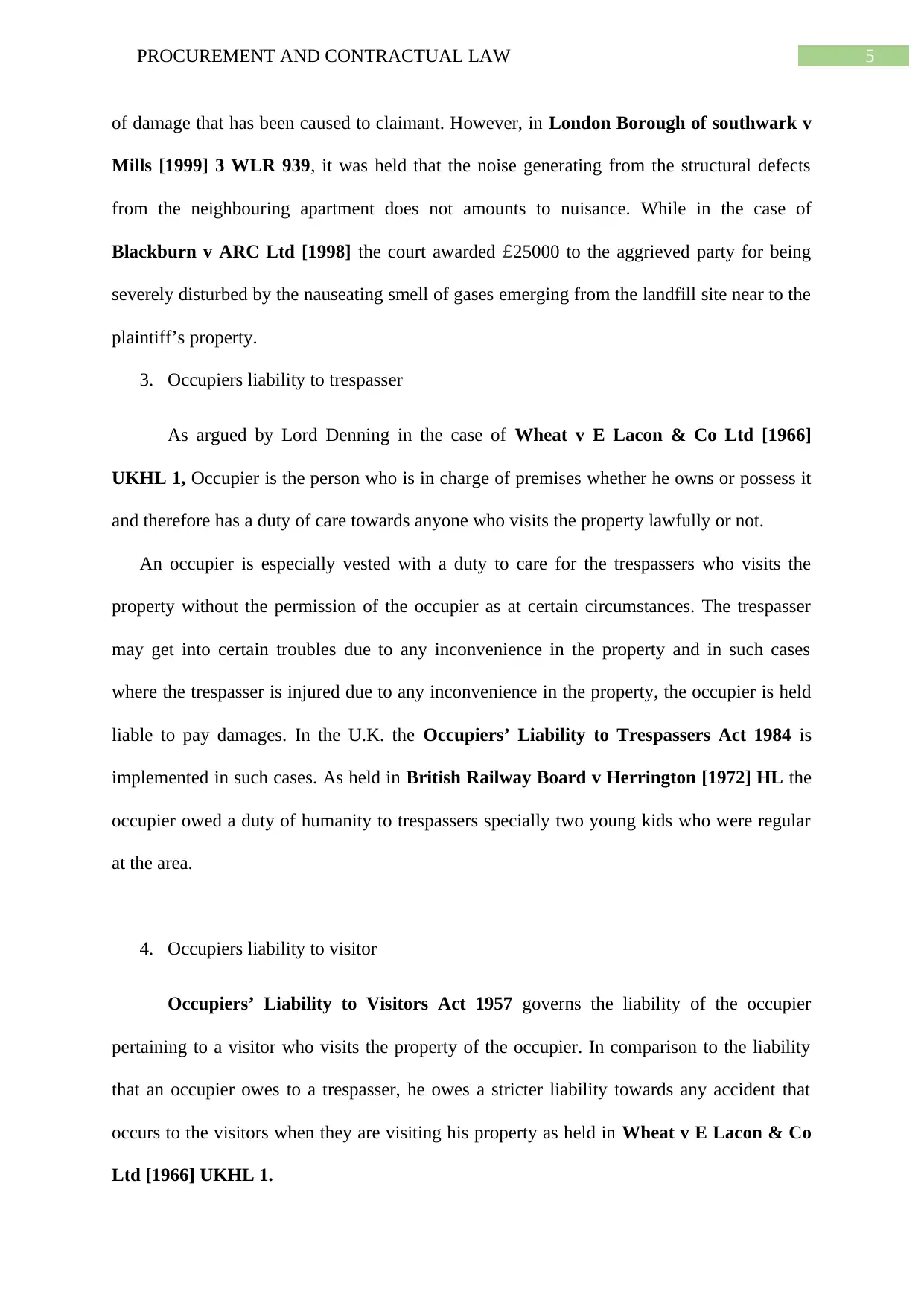
5PROCUREMENT AND CONTRACTUAL LAW
of damage that has been caused to claimant. However, in London Borough of southwark v
Mills [1999] 3 WLR 939, it was held that the noise generating from the structural defects
from the neighbouring apartment does not amounts to nuisance. While in the case of
Blackburn v ARC Ltd [1998] the court awarded £25000 to the aggrieved party for being
severely disturbed by the nauseating smell of gases emerging from the landfill site near to the
plaintiff’s property.
3. Occupiers liability to trespasser
As argued by Lord Denning in the case of Wheat v E Lacon & Co Ltd [1966]
UKHL 1, Occupier is the person who is in charge of premises whether he owns or possess it
and therefore has a duty of care towards anyone who visits the property lawfully or not.
An occupier is especially vested with a duty to care for the trespassers who visits the
property without the permission of the occupier as at certain circumstances. The trespasser
may get into certain troubles due to any inconvenience in the property and in such cases
where the trespasser is injured due to any inconvenience in the property, the occupier is held
liable to pay damages. In the U.K. the Occupiers’ Liability to Trespassers Act 1984 is
implemented in such cases. As held in British Railway Board v Herrington [1972] HL the
occupier owed a duty of humanity to trespassers specially two young kids who were regular
at the area.
4. Occupiers liability to visitor
Occupiers’ Liability to Visitors Act 1957 governs the liability of the occupier
pertaining to a visitor who visits the property of the occupier. In comparison to the liability
that an occupier owes to a trespasser, he owes a stricter liability towards any accident that
occurs to the visitors when they are visiting his property as held in Wheat v E Lacon & Co
Ltd [1966] UKHL 1.
of damage that has been caused to claimant. However, in London Borough of southwark v
Mills [1999] 3 WLR 939, it was held that the noise generating from the structural defects
from the neighbouring apartment does not amounts to nuisance. While in the case of
Blackburn v ARC Ltd [1998] the court awarded £25000 to the aggrieved party for being
severely disturbed by the nauseating smell of gases emerging from the landfill site near to the
plaintiff’s property.
3. Occupiers liability to trespasser
As argued by Lord Denning in the case of Wheat v E Lacon & Co Ltd [1966]
UKHL 1, Occupier is the person who is in charge of premises whether he owns or possess it
and therefore has a duty of care towards anyone who visits the property lawfully or not.
An occupier is especially vested with a duty to care for the trespassers who visits the
property without the permission of the occupier as at certain circumstances. The trespasser
may get into certain troubles due to any inconvenience in the property and in such cases
where the trespasser is injured due to any inconvenience in the property, the occupier is held
liable to pay damages. In the U.K. the Occupiers’ Liability to Trespassers Act 1984 is
implemented in such cases. As held in British Railway Board v Herrington [1972] HL the
occupier owed a duty of humanity to trespassers specially two young kids who were regular
at the area.
4. Occupiers liability to visitor
Occupiers’ Liability to Visitors Act 1957 governs the liability of the occupier
pertaining to a visitor who visits the property of the occupier. In comparison to the liability
that an occupier owes to a trespasser, he owes a stricter liability towards any accident that
occurs to the visitors when they are visiting his property as held in Wheat v E Lacon & Co
Ltd [1966] UKHL 1.
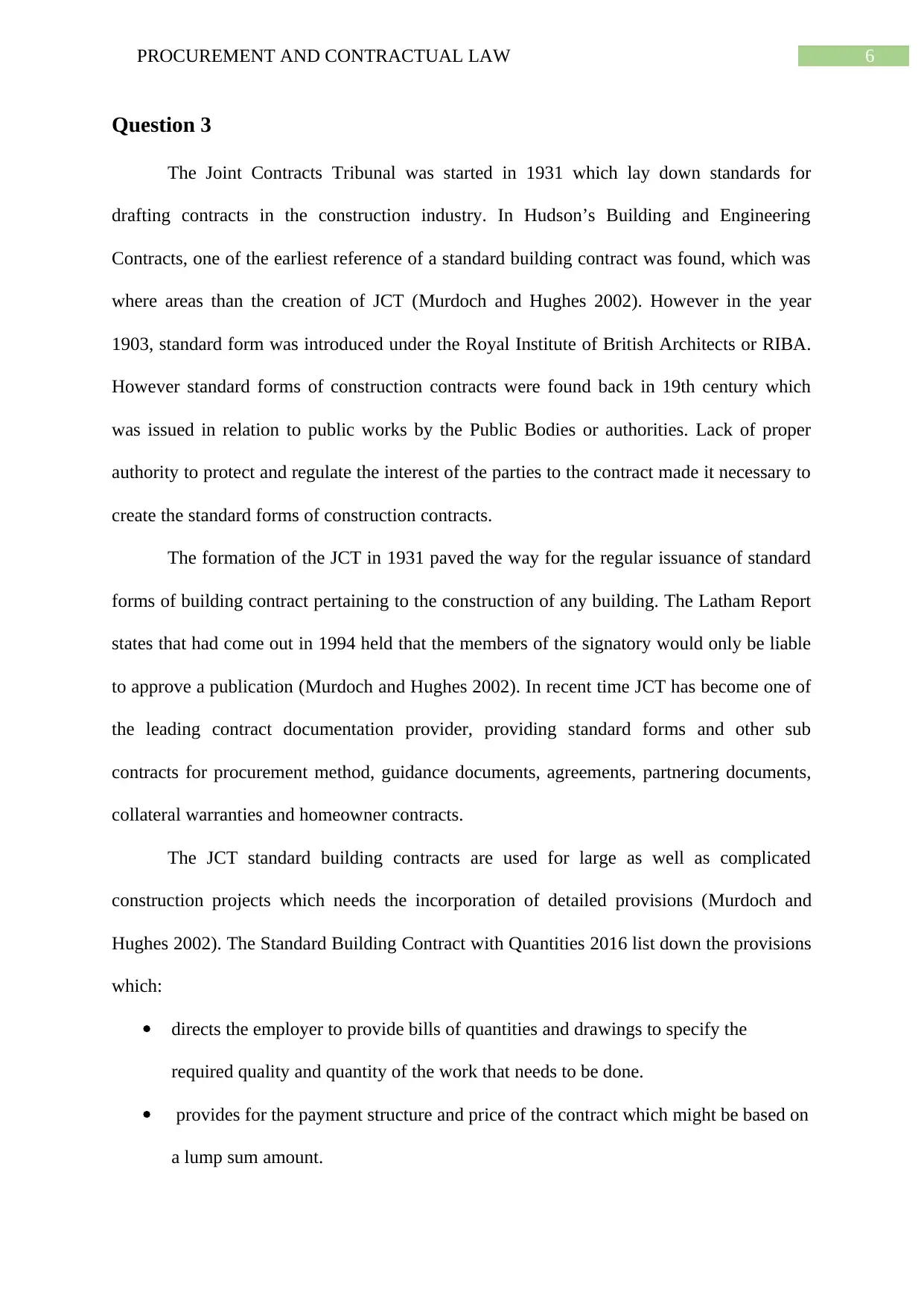
6PROCUREMENT AND CONTRACTUAL LAW
Question 3
The Joint Contracts Tribunal was started in 1931 which lay down standards for
drafting contracts in the construction industry. In Hudson’s Building and Engineering
Contracts, one of the earliest reference of a standard building contract was found, which was
where areas than the creation of JCT (Murdoch and Hughes 2002). However in the year
1903, standard form was introduced under the Royal Institute of British Architects or RIBA.
However standard forms of construction contracts were found back in 19th century which
was issued in relation to public works by the Public Bodies or authorities. Lack of proper
authority to protect and regulate the interest of the parties to the contract made it necessary to
create the standard forms of construction contracts.
The formation of the JCT in 1931 paved the way for the regular issuance of standard
forms of building contract pertaining to the construction of any building. The Latham Report
states that had come out in 1994 held that the members of the signatory would only be liable
to approve a publication (Murdoch and Hughes 2002). In recent time JCT has become one of
the leading contract documentation provider, providing standard forms and other sub
contracts for procurement method, guidance documents, agreements, partnering documents,
collateral warranties and homeowner contracts.
The JCT standard building contracts are used for large as well as complicated
construction projects which needs the incorporation of detailed provisions (Murdoch and
Hughes 2002). The Standard Building Contract with Quantities 2016 list down the provisions
which:
directs the employer to provide bills of quantities and drawings to specify the
required quality and quantity of the work that needs to be done.
provides for the payment structure and price of the contract which might be based on
a lump sum amount.
Question 3
The Joint Contracts Tribunal was started in 1931 which lay down standards for
drafting contracts in the construction industry. In Hudson’s Building and Engineering
Contracts, one of the earliest reference of a standard building contract was found, which was
where areas than the creation of JCT (Murdoch and Hughes 2002). However in the year
1903, standard form was introduced under the Royal Institute of British Architects or RIBA.
However standard forms of construction contracts were found back in 19th century which
was issued in relation to public works by the Public Bodies or authorities. Lack of proper
authority to protect and regulate the interest of the parties to the contract made it necessary to
create the standard forms of construction contracts.
The formation of the JCT in 1931 paved the way for the regular issuance of standard
forms of building contract pertaining to the construction of any building. The Latham Report
states that had come out in 1994 held that the members of the signatory would only be liable
to approve a publication (Murdoch and Hughes 2002). In recent time JCT has become one of
the leading contract documentation provider, providing standard forms and other sub
contracts for procurement method, guidance documents, agreements, partnering documents,
collateral warranties and homeowner contracts.
The JCT standard building contracts are used for large as well as complicated
construction projects which needs the incorporation of detailed provisions (Murdoch and
Hughes 2002). The Standard Building Contract with Quantities 2016 list down the provisions
which:
directs the employer to provide bills of quantities and drawings to specify the
required quality and quantity of the work that needs to be done.
provides for the payment structure and price of the contract which might be based on
a lump sum amount.
Paraphrase This Document
Need a fresh take? Get an instant paraphrase of this document with our AI Paraphraser
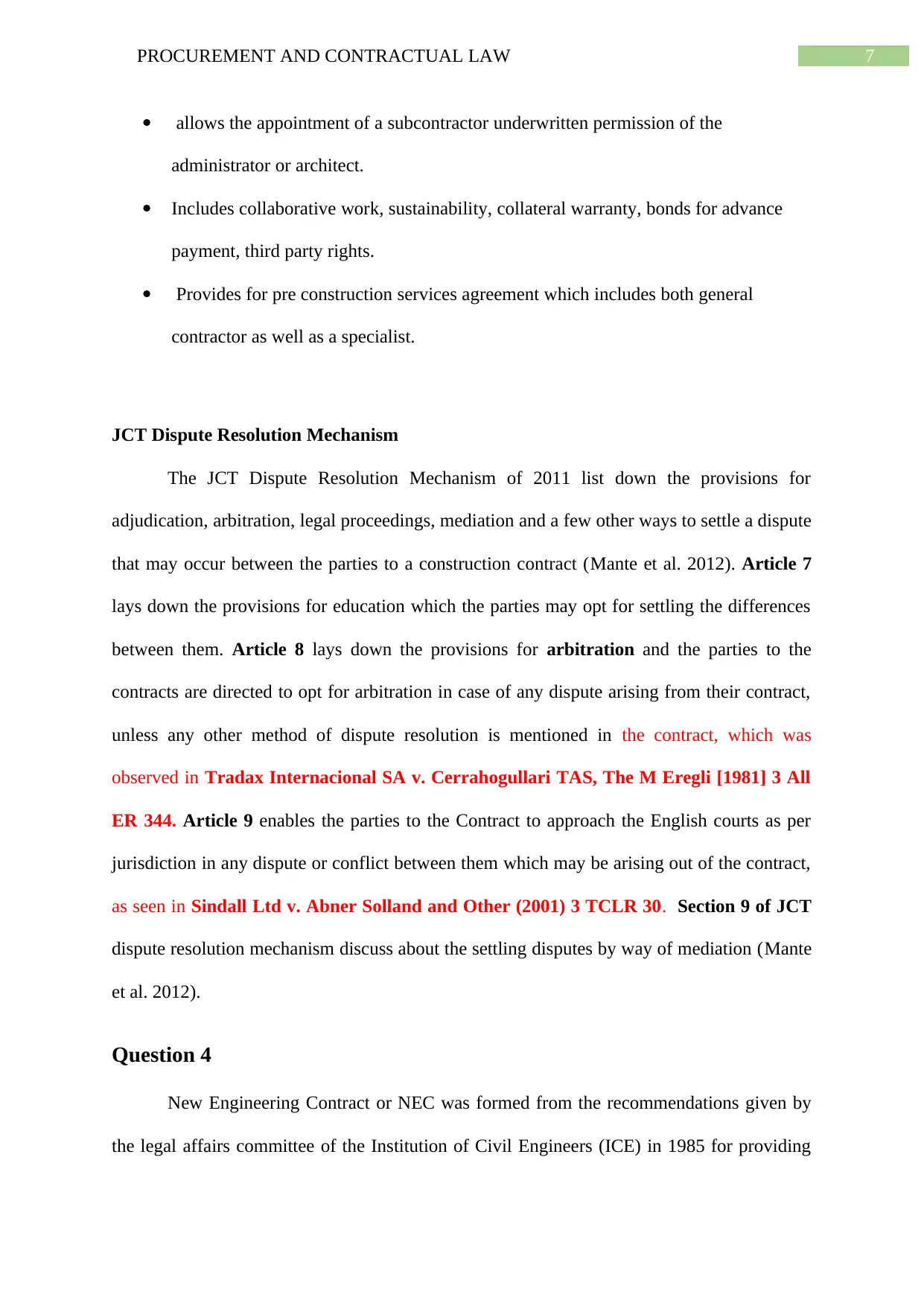
7PROCUREMENT AND CONTRACTUAL LAW
allows the appointment of a subcontractor underwritten permission of the
administrator or architect.
Includes collaborative work, sustainability, collateral warranty, bonds for advance
payment, third party rights.
Provides for pre construction services agreement which includes both general
contractor as well as a specialist.
JCT Dispute Resolution Mechanism
The JCT Dispute Resolution Mechanism of 2011 list down the provisions for
adjudication, arbitration, legal proceedings, mediation and a few other ways to settle a dispute
that may occur between the parties to a construction contract (Mante et al. 2012). Article 7
lays down the provisions for education which the parties may opt for settling the differences
between them. Article 8 lays down the provisions for arbitration and the parties to the
contracts are directed to opt for arbitration in case of any dispute arising from their contract,
unless any other method of dispute resolution is mentioned in the contract, which was
observed in Tradax Internacional SA v. Cerrahogullari TAS, The M Eregli [1981] 3 All
ER 344. Article 9 enables the parties to the Contract to approach the English courts as per
jurisdiction in any dispute or conflict between them which may be arising out of the contract,
as seen in Sindall Ltd v. Abner Solland and Other (2001) 3 TCLR 30. Section 9 of JCT
dispute resolution mechanism discuss about the settling disputes by way of mediation (Mante
et al. 2012).
Question 4
New Engineering Contract or NEC was formed from the recommendations given by
the legal affairs committee of the Institution of Civil Engineers (ICE) in 1985 for providing
allows the appointment of a subcontractor underwritten permission of the
administrator or architect.
Includes collaborative work, sustainability, collateral warranty, bonds for advance
payment, third party rights.
Provides for pre construction services agreement which includes both general
contractor as well as a specialist.
JCT Dispute Resolution Mechanism
The JCT Dispute Resolution Mechanism of 2011 list down the provisions for
adjudication, arbitration, legal proceedings, mediation and a few other ways to settle a dispute
that may occur between the parties to a construction contract (Mante et al. 2012). Article 7
lays down the provisions for education which the parties may opt for settling the differences
between them. Article 8 lays down the provisions for arbitration and the parties to the
contracts are directed to opt for arbitration in case of any dispute arising from their contract,
unless any other method of dispute resolution is mentioned in the contract, which was
observed in Tradax Internacional SA v. Cerrahogullari TAS, The M Eregli [1981] 3 All
ER 344. Article 9 enables the parties to the Contract to approach the English courts as per
jurisdiction in any dispute or conflict between them which may be arising out of the contract,
as seen in Sindall Ltd v. Abner Solland and Other (2001) 3 TCLR 30. Section 9 of JCT
dispute resolution mechanism discuss about the settling disputes by way of mediation (Mante
et al. 2012).
Question 4
New Engineering Contract or NEC was formed from the recommendations given by
the legal affairs committee of the Institution of Civil Engineers (ICE) in 1985 for providing
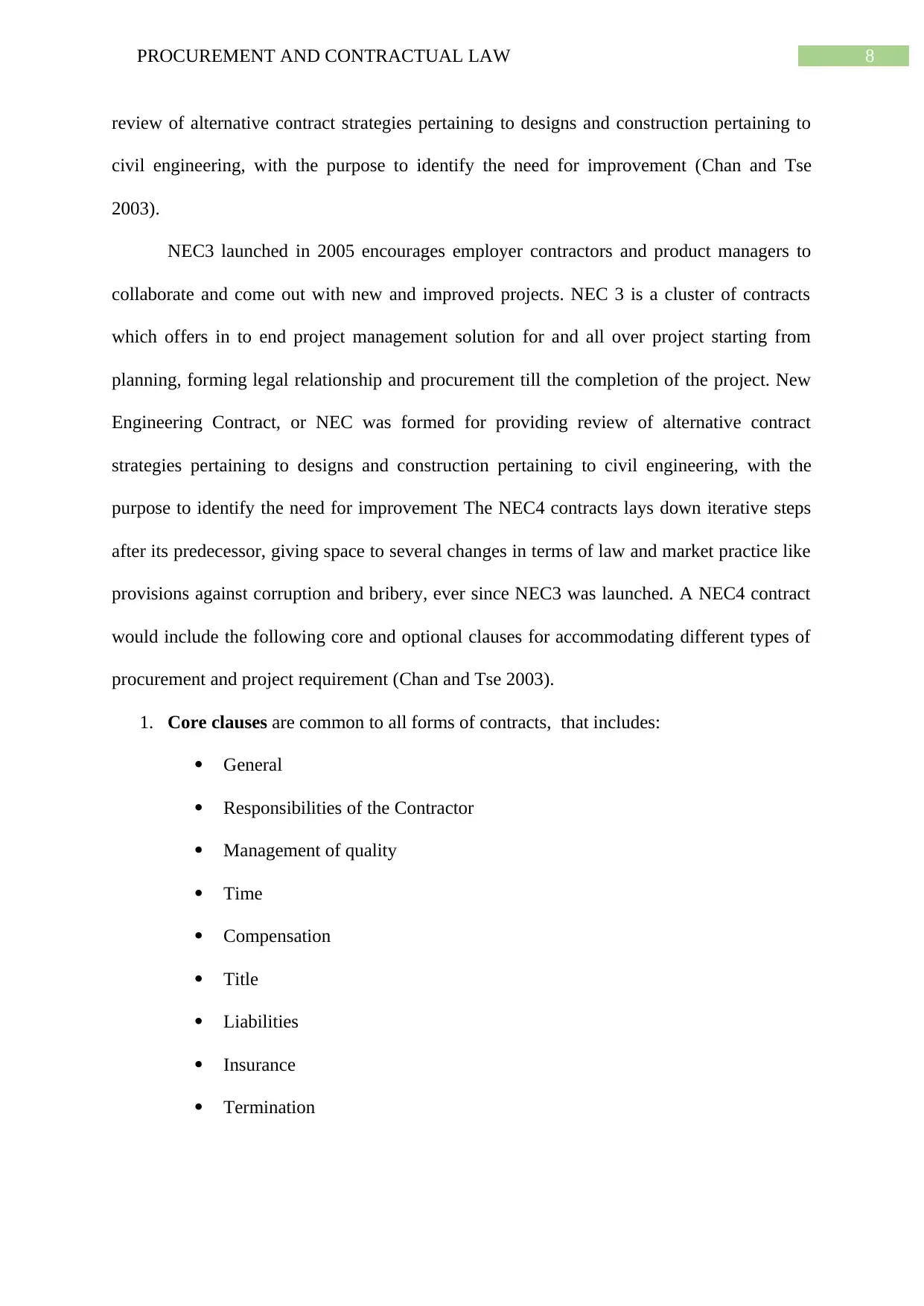
8PROCUREMENT AND CONTRACTUAL LAW
review of alternative contract strategies pertaining to designs and construction pertaining to
civil engineering, with the purpose to identify the need for improvement (Chan and Tse
2003).
NEC3 launched in 2005 encourages employer contractors and product managers to
collaborate and come out with new and improved projects. NEC 3 is a cluster of contracts
which offers in to end project management solution for and all over project starting from
planning, forming legal relationship and procurement till the completion of the project. New
Engineering Contract, or NEC was formed for providing review of alternative contract
strategies pertaining to designs and construction pertaining to civil engineering, with the
purpose to identify the need for improvement The NEC4 contracts lays down iterative steps
after its predecessor, giving space to several changes in terms of law and market practice like
provisions against corruption and bribery, ever since NEC3 was launched. A NEC4 contract
would include the following core and optional clauses for accommodating different types of
procurement and project requirement (Chan and Tse 2003).
1. Core clauses are common to all forms of contracts, that includes:
General
Responsibilities of the Contractor
Management of quality
Time
Compensation
Title
Liabilities
Insurance
Termination
review of alternative contract strategies pertaining to designs and construction pertaining to
civil engineering, with the purpose to identify the need for improvement (Chan and Tse
2003).
NEC3 launched in 2005 encourages employer contractors and product managers to
collaborate and come out with new and improved projects. NEC 3 is a cluster of contracts
which offers in to end project management solution for and all over project starting from
planning, forming legal relationship and procurement till the completion of the project. New
Engineering Contract, or NEC was formed for providing review of alternative contract
strategies pertaining to designs and construction pertaining to civil engineering, with the
purpose to identify the need for improvement The NEC4 contracts lays down iterative steps
after its predecessor, giving space to several changes in terms of law and market practice like
provisions against corruption and bribery, ever since NEC3 was launched. A NEC4 contract
would include the following core and optional clauses for accommodating different types of
procurement and project requirement (Chan and Tse 2003).
1. Core clauses are common to all forms of contracts, that includes:
General
Responsibilities of the Contractor
Management of quality
Time
Compensation
Title
Liabilities
Insurance
Termination
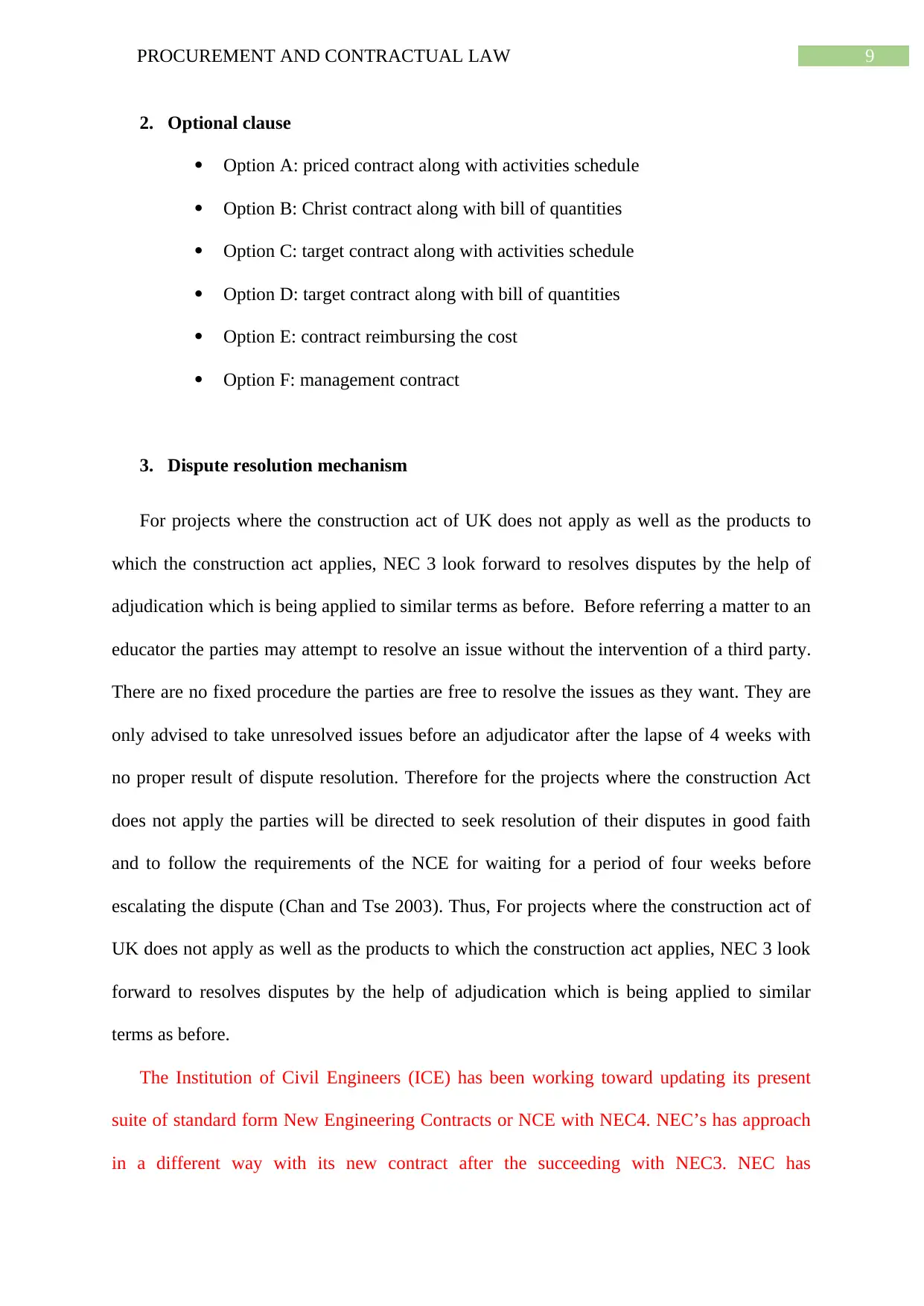
9PROCUREMENT AND CONTRACTUAL LAW
2. Optional clause
Option A: priced contract along with activities schedule
Option B: Christ contract along with bill of quantities
Option C: target contract along with activities schedule
Option D: target contract along with bill of quantities
Option E: contract reimbursing the cost
Option F: management contract
3. Dispute resolution mechanism
For projects where the construction act of UK does not apply as well as the products to
which the construction act applies, NEC 3 look forward to resolves disputes by the help of
adjudication which is being applied to similar terms as before. Before referring a matter to an
educator the parties may attempt to resolve an issue without the intervention of a third party.
There are no fixed procedure the parties are free to resolve the issues as they want. They are
only advised to take unresolved issues before an adjudicator after the lapse of 4 weeks with
no proper result of dispute resolution. Therefore for the projects where the construction Act
does not apply the parties will be directed to seek resolution of their disputes in good faith
and to follow the requirements of the NCE for waiting for a period of four weeks before
escalating the dispute (Chan and Tse 2003). Thus, For projects where the construction act of
UK does not apply as well as the products to which the construction act applies, NEC 3 look
forward to resolves disputes by the help of adjudication which is being applied to similar
terms as before.
The Institution of Civil Engineers (ICE) has been working toward updating its present
suite of standard form New Engineering Contracts or NCE with NEC4. NEC’s has approach
in a different way with its new contract after the succeeding with NEC3. NEC has
2. Optional clause
Option A: priced contract along with activities schedule
Option B: Christ contract along with bill of quantities
Option C: target contract along with activities schedule
Option D: target contract along with bill of quantities
Option E: contract reimbursing the cost
Option F: management contract
3. Dispute resolution mechanism
For projects where the construction act of UK does not apply as well as the products to
which the construction act applies, NEC 3 look forward to resolves disputes by the help of
adjudication which is being applied to similar terms as before. Before referring a matter to an
educator the parties may attempt to resolve an issue without the intervention of a third party.
There are no fixed procedure the parties are free to resolve the issues as they want. They are
only advised to take unresolved issues before an adjudicator after the lapse of 4 weeks with
no proper result of dispute resolution. Therefore for the projects where the construction Act
does not apply the parties will be directed to seek resolution of their disputes in good faith
and to follow the requirements of the NCE for waiting for a period of four weeks before
escalating the dispute (Chan and Tse 2003). Thus, For projects where the construction act of
UK does not apply as well as the products to which the construction act applies, NEC 3 look
forward to resolves disputes by the help of adjudication which is being applied to similar
terms as before.
The Institution of Civil Engineers (ICE) has been working toward updating its present
suite of standard form New Engineering Contracts or NCE with NEC4. NEC’s has approach
in a different way with its new contract after the succeeding with NEC3. NEC has
Secure Best Marks with AI Grader
Need help grading? Try our AI Grader for instant feedback on your assignments.
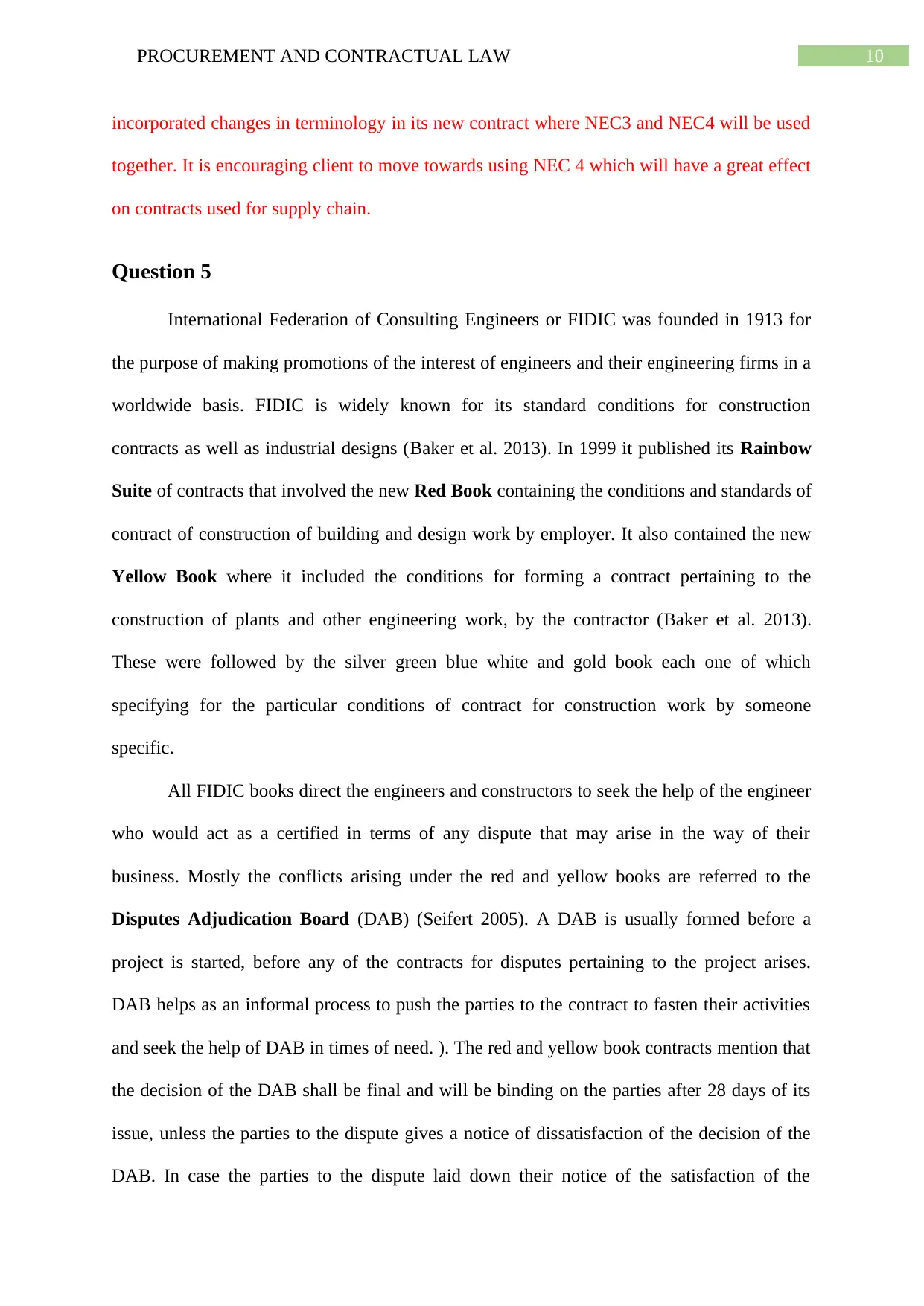
10PROCUREMENT AND CONTRACTUAL LAW
incorporated changes in terminology in its new contract where NEC3 and NEC4 will be used
together. It is encouraging client to move towards using NEC 4 which will have a great effect
on contracts used for supply chain.
Question 5
International Federation of Consulting Engineers or FIDIC was founded in 1913 for
the purpose of making promotions of the interest of engineers and their engineering firms in a
worldwide basis. FIDIC is widely known for its standard conditions for construction
contracts as well as industrial designs (Baker et al. 2013). In 1999 it published its Rainbow
Suite of contracts that involved the new Red Book containing the conditions and standards of
contract of construction of building and design work by employer. It also contained the new
Yellow Book where it included the conditions for forming a contract pertaining to the
construction of plants and other engineering work, by the contractor (Baker et al. 2013).
These were followed by the silver green blue white and gold book each one of which
specifying for the particular conditions of contract for construction work by someone
specific.
All FIDIC books direct the engineers and constructors to seek the help of the engineer
who would act as a certified in terms of any dispute that may arise in the way of their
business. Mostly the conflicts arising under the red and yellow books are referred to the
Disputes Adjudication Board (DAB) (Seifert 2005). A DAB is usually formed before a
project is started, before any of the contracts for disputes pertaining to the project arises.
DAB helps as an informal process to push the parties to the contract to fasten their activities
and seek the help of DAB in times of need. ). The red and yellow book contracts mention that
the decision of the DAB shall be final and will be binding on the parties after 28 days of its
issue, unless the parties to the dispute gives a notice of dissatisfaction of the decision of the
DAB. In case the parties to the dispute laid down their notice of the satisfaction of the
incorporated changes in terminology in its new contract where NEC3 and NEC4 will be used
together. It is encouraging client to move towards using NEC 4 which will have a great effect
on contracts used for supply chain.
Question 5
International Federation of Consulting Engineers or FIDIC was founded in 1913 for
the purpose of making promotions of the interest of engineers and their engineering firms in a
worldwide basis. FIDIC is widely known for its standard conditions for construction
contracts as well as industrial designs (Baker et al. 2013). In 1999 it published its Rainbow
Suite of contracts that involved the new Red Book containing the conditions and standards of
contract of construction of building and design work by employer. It also contained the new
Yellow Book where it included the conditions for forming a contract pertaining to the
construction of plants and other engineering work, by the contractor (Baker et al. 2013).
These were followed by the silver green blue white and gold book each one of which
specifying for the particular conditions of contract for construction work by someone
specific.
All FIDIC books direct the engineers and constructors to seek the help of the engineer
who would act as a certified in terms of any dispute that may arise in the way of their
business. Mostly the conflicts arising under the red and yellow books are referred to the
Disputes Adjudication Board (DAB) (Seifert 2005). A DAB is usually formed before a
project is started, before any of the contracts for disputes pertaining to the project arises.
DAB helps as an informal process to push the parties to the contract to fasten their activities
and seek the help of DAB in times of need. ). The red and yellow book contracts mention that
the decision of the DAB shall be final and will be binding on the parties after 28 days of its
issue, unless the parties to the dispute gives a notice of dissatisfaction of the decision of the
DAB. In case the parties to the dispute laid down their notice of the satisfaction of the
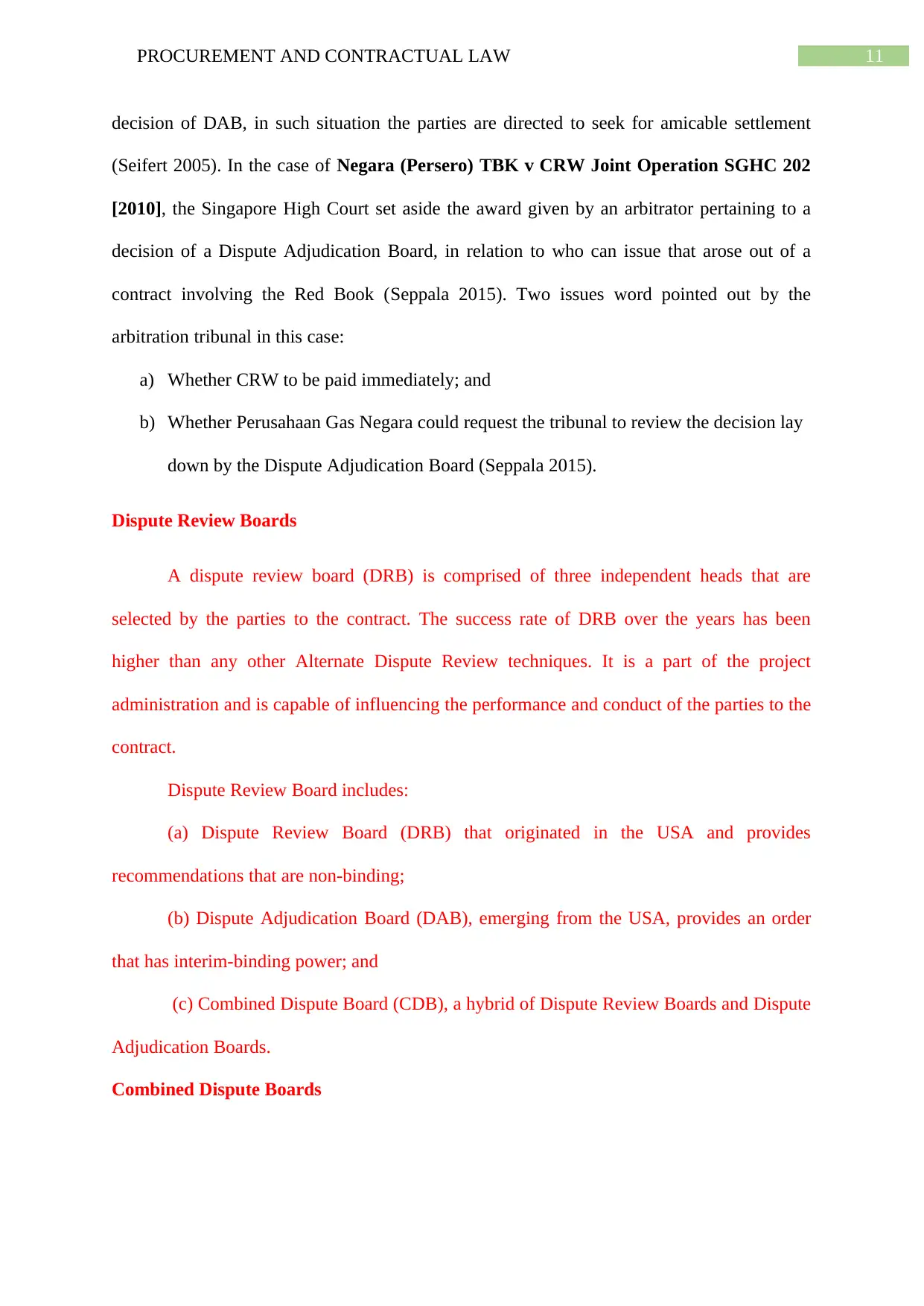
11PROCUREMENT AND CONTRACTUAL LAW
decision of DAB, in such situation the parties are directed to seek for amicable settlement
(Seifert 2005). In the case of Negara (Persero) TBK v CRW Joint Operation SGHC 202
[2010], the Singapore High Court set aside the award given by an arbitrator pertaining to a
decision of a Dispute Adjudication Board, in relation to who can issue that arose out of a
contract involving the Red Book (Seppala 2015). Two issues word pointed out by the
arbitration tribunal in this case:
a) Whether CRW to be paid immediately; and
b) Whether Perusahaan Gas Negara could request the tribunal to review the decision lay
down by the Dispute Adjudication Board (Seppala 2015).
Dispute Review Boards
A dispute review board (DRB) is comprised of three independent heads that are
selected by the parties to the contract. The success rate of DRB over the years has been
higher than any other Alternate Dispute Review techniques. It is a part of the project
administration and is capable of influencing the performance and conduct of the parties to the
contract.
Dispute Review Board includes:
(a) Dispute Review Board (DRB) that originated in the USA and provides
recommendations that are non-binding;
(b) Dispute Adjudication Board (DAB), emerging from the USA, provides an order
that has interim-binding power; and
(c) Combined Dispute Board (CDB), a hybrid of Dispute Review Boards and Dispute
Adjudication Boards.
Combined Dispute Boards
decision of DAB, in such situation the parties are directed to seek for amicable settlement
(Seifert 2005). In the case of Negara (Persero) TBK v CRW Joint Operation SGHC 202
[2010], the Singapore High Court set aside the award given by an arbitrator pertaining to a
decision of a Dispute Adjudication Board, in relation to who can issue that arose out of a
contract involving the Red Book (Seppala 2015). Two issues word pointed out by the
arbitration tribunal in this case:
a) Whether CRW to be paid immediately; and
b) Whether Perusahaan Gas Negara could request the tribunal to review the decision lay
down by the Dispute Adjudication Board (Seppala 2015).
Dispute Review Boards
A dispute review board (DRB) is comprised of three independent heads that are
selected by the parties to the contract. The success rate of DRB over the years has been
higher than any other Alternate Dispute Review techniques. It is a part of the project
administration and is capable of influencing the performance and conduct of the parties to the
contract.
Dispute Review Board includes:
(a) Dispute Review Board (DRB) that originated in the USA and provides
recommendations that are non-binding;
(b) Dispute Adjudication Board (DAB), emerging from the USA, provides an order
that has interim-binding power; and
(c) Combined Dispute Board (CDB), a hybrid of Dispute Review Boards and Dispute
Adjudication Boards.
Combined Dispute Boards
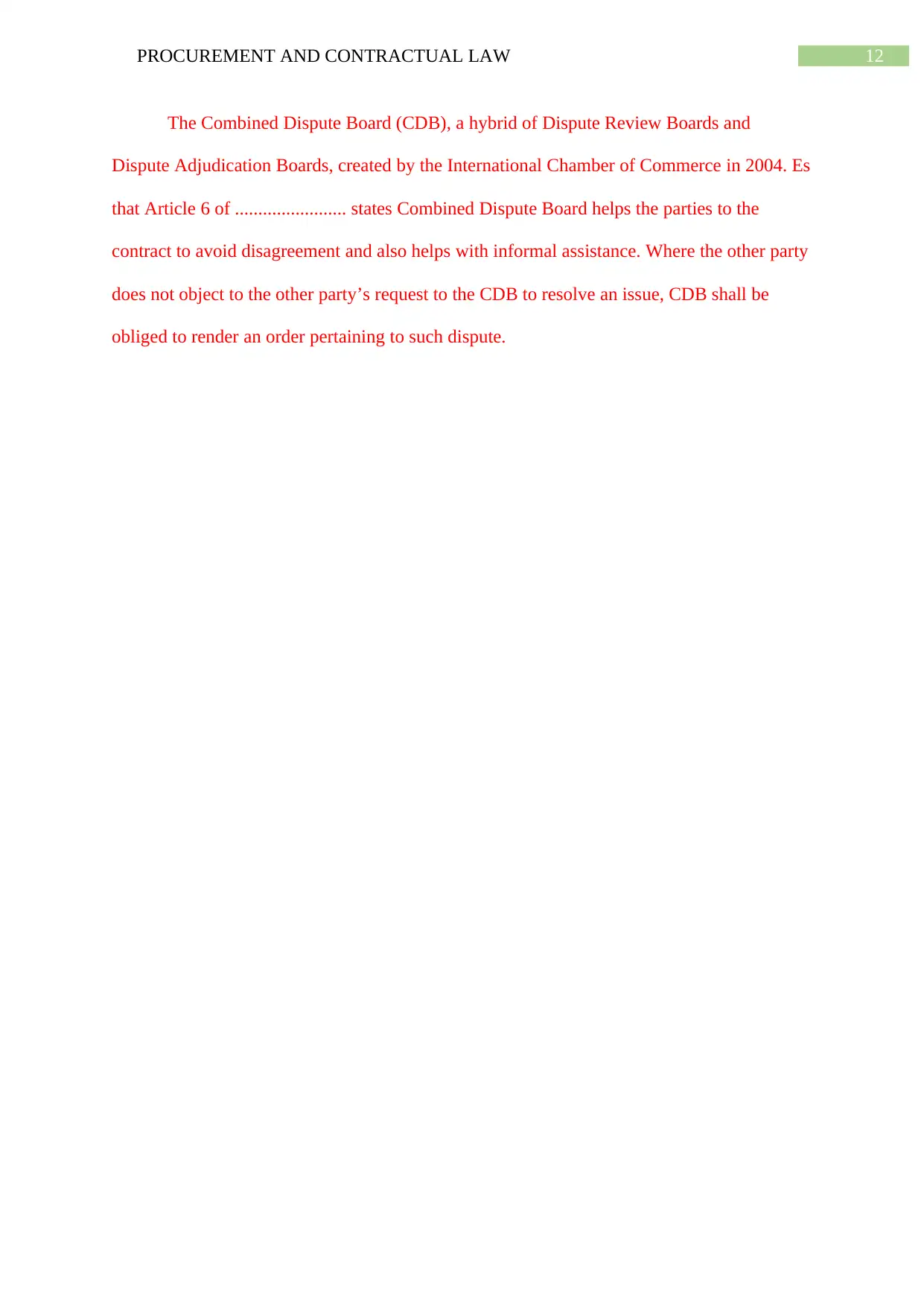
12PROCUREMENT AND CONTRACTUAL LAW
The Combined Dispute Board (CDB), a hybrid of Dispute Review Boards and
Dispute Adjudication Boards, created by the International Chamber of Commerce in 2004. Es
that Article 6 of ........................ states Combined Dispute Board helps the parties to the
contract to avoid disagreement and also helps with informal assistance. Where the other party
does not object to the other party’s request to the CDB to resolve an issue, CDB shall be
obliged to render an order pertaining to such dispute.
The Combined Dispute Board (CDB), a hybrid of Dispute Review Boards and
Dispute Adjudication Boards, created by the International Chamber of Commerce in 2004. Es
that Article 6 of ........................ states Combined Dispute Board helps the parties to the
contract to avoid disagreement and also helps with informal assistance. Where the other party
does not object to the other party’s request to the CDB to resolve an issue, CDB shall be
obliged to render an order pertaining to such dispute.
Paraphrase This Document
Need a fresh take? Get an instant paraphrase of this document with our AI Paraphraser
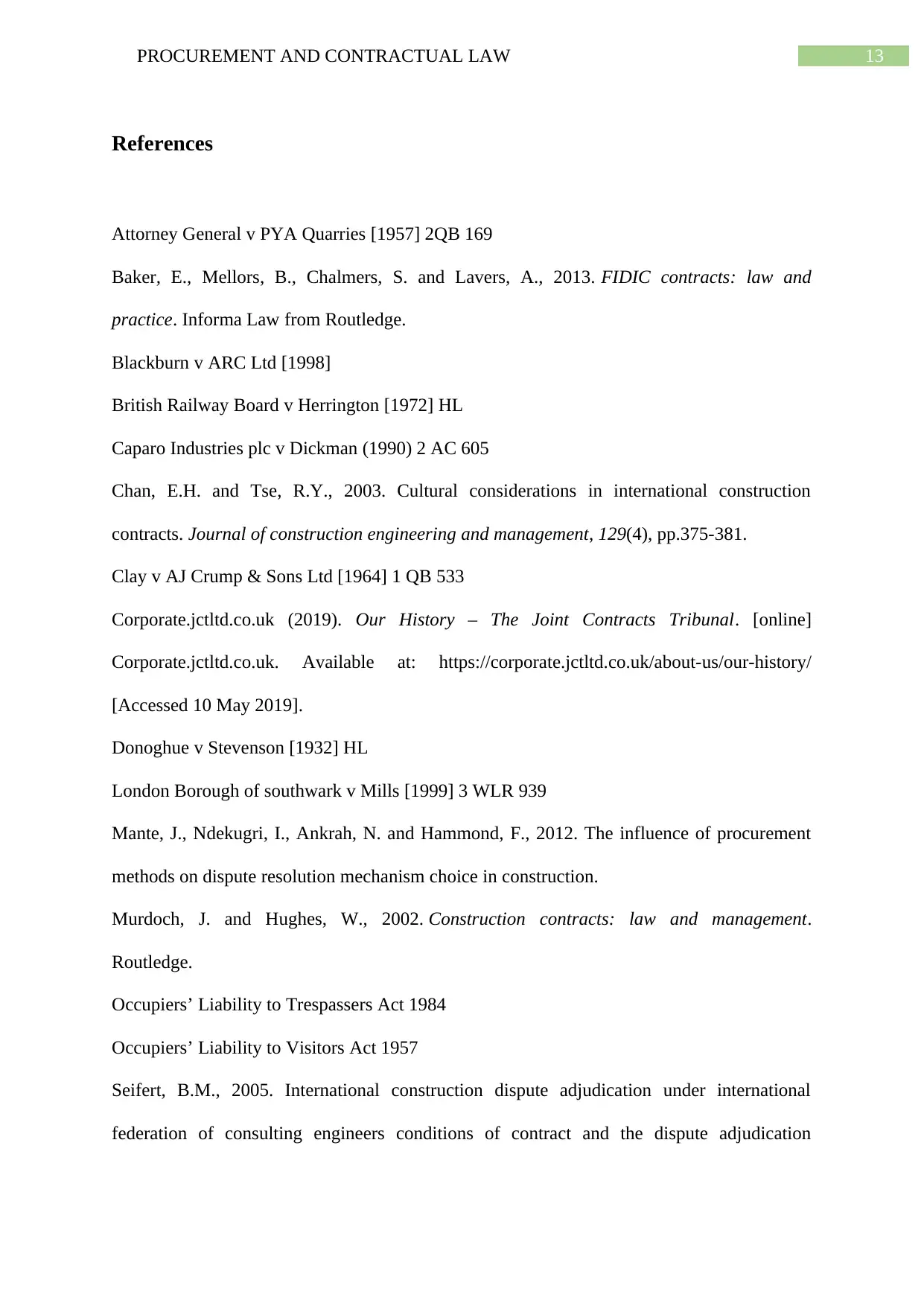
13PROCUREMENT AND CONTRACTUAL LAW
References
Attorney General v PYA Quarries [1957] 2QB 169
Baker, E., Mellors, B., Chalmers, S. and Lavers, A., 2013. FIDIC contracts: law and
practice. Informa Law from Routledge.
Blackburn v ARC Ltd [1998]
British Railway Board v Herrington [1972] HL
Caparo Industries plc v Dickman (1990) 2 AC 605
Chan, E.H. and Tse, R.Y., 2003. Cultural considerations in international construction
contracts. Journal of construction engineering and management, 129(4), pp.375-381.
Clay v AJ Crump & Sons Ltd [1964] 1 QB 533
Corporate.jctltd.co.uk (2019). Our History – The Joint Contracts Tribunal. [online]
Corporate.jctltd.co.uk. Available at: https://corporate.jctltd.co.uk/about-us/our-history/
[Accessed 10 May 2019].
Donoghue v Stevenson [1932] HL
London Borough of southwark v Mills [1999] 3 WLR 939
Mante, J., Ndekugri, I., Ankrah, N. and Hammond, F., 2012. The influence of procurement
methods on dispute resolution mechanism choice in construction.
Murdoch, J. and Hughes, W., 2002. Construction contracts: law and management.
Routledge.
Occupiers’ Liability to Trespassers Act 1984
Occupiers’ Liability to Visitors Act 1957
Seifert, B.M., 2005. International construction dispute adjudication under international
federation of consulting engineers conditions of contract and the dispute adjudication
References
Attorney General v PYA Quarries [1957] 2QB 169
Baker, E., Mellors, B., Chalmers, S. and Lavers, A., 2013. FIDIC contracts: law and
practice. Informa Law from Routledge.
Blackburn v ARC Ltd [1998]
British Railway Board v Herrington [1972] HL
Caparo Industries plc v Dickman (1990) 2 AC 605
Chan, E.H. and Tse, R.Y., 2003. Cultural considerations in international construction
contracts. Journal of construction engineering and management, 129(4), pp.375-381.
Clay v AJ Crump & Sons Ltd [1964] 1 QB 533
Corporate.jctltd.co.uk (2019). Our History – The Joint Contracts Tribunal. [online]
Corporate.jctltd.co.uk. Available at: https://corporate.jctltd.co.uk/about-us/our-history/
[Accessed 10 May 2019].
Donoghue v Stevenson [1932] HL
London Borough of southwark v Mills [1999] 3 WLR 939
Mante, J., Ndekugri, I., Ankrah, N. and Hammond, F., 2012. The influence of procurement
methods on dispute resolution mechanism choice in construction.
Murdoch, J. and Hughes, W., 2002. Construction contracts: law and management.
Routledge.
Occupiers’ Liability to Trespassers Act 1984
Occupiers’ Liability to Visitors Act 1957
Seifert, B.M., 2005. International construction dispute adjudication under international
federation of consulting engineers conditions of contract and the dispute adjudication
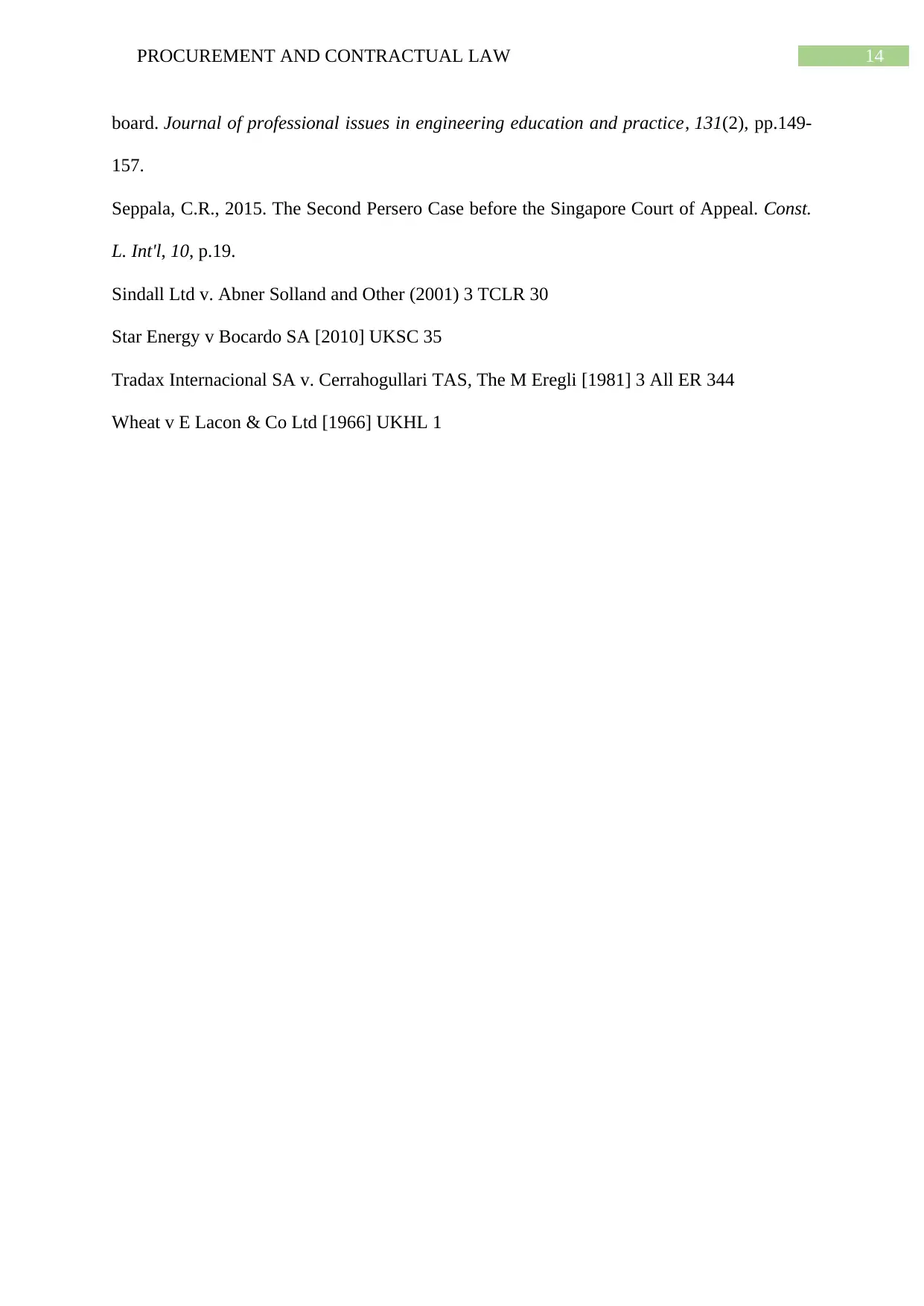
14PROCUREMENT AND CONTRACTUAL LAW
board. Journal of professional issues in engineering education and practice, 131(2), pp.149-
157.
Seppala, C.R., 2015. The Second Persero Case before the Singapore Court of Appeal. Const.
L. Int'l, 10, p.19.
Sindall Ltd v. Abner Solland and Other (2001) 3 TCLR 30
Star Energy v Bocardo SA [2010] UKSC 35
Tradax Internacional SA v. Cerrahogullari TAS, The M Eregli [1981] 3 All ER 344
Wheat v E Lacon & Co Ltd [1966] UKHL 1
board. Journal of professional issues in engineering education and practice, 131(2), pp.149-
157.
Seppala, C.R., 2015. The Second Persero Case before the Singapore Court of Appeal. Const.
L. Int'l, 10, p.19.
Sindall Ltd v. Abner Solland and Other (2001) 3 TCLR 30
Star Energy v Bocardo SA [2010] UKSC 35
Tradax Internacional SA v. Cerrahogullari TAS, The M Eregli [1981] 3 All ER 344
Wheat v E Lacon & Co Ltd [1966] UKHL 1
1 out of 15
Related Documents
Your All-in-One AI-Powered Toolkit for Academic Success.
+13062052269
info@desklib.com
Available 24*7 on WhatsApp / Email
![[object Object]](/_next/static/media/star-bottom.7253800d.svg)
Unlock your academic potential
© 2024 | Zucol Services PVT LTD | All rights reserved.





